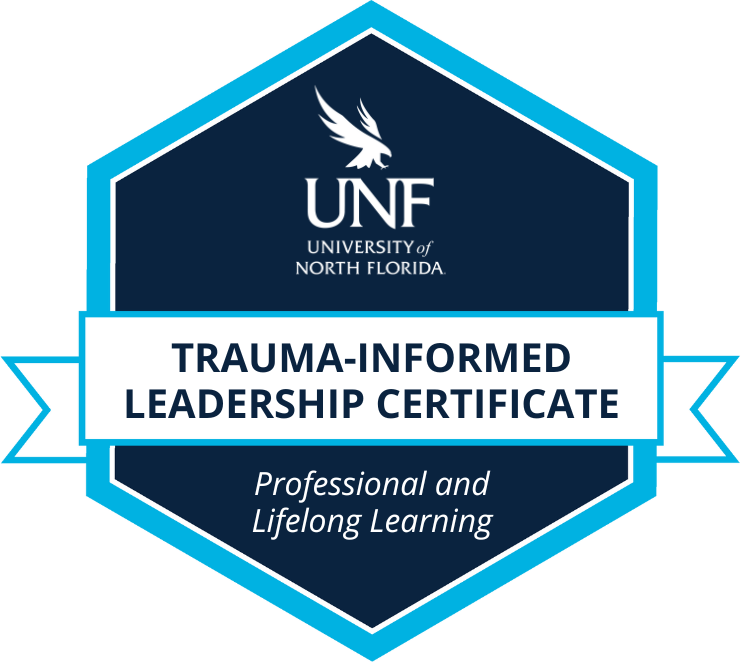Trauma-Informed Leadership Certificate

Trauma-informed leadership is a leadership approach by which the leader acknowledges how their own social and emotional experiences influence the way they interact, communicate, influence, and engage anyone who has an interest in the success of themselves, others, and their organization. A trauma-informed leader understands the importance of assessing, executing, modeling, and measuring the 3 ^ 3 The Power of 3 organizational design concepts.
Dr. Dawn Emerick calls for a mental health revolution—starting with trauma-free leadership and psychologically safe workplaces.
Content Structure
- Three 90-minute live, virtual sessions
- Action learning experiences
- Reflect upon knowledge of concepts and personal experiences
- Interactive lectures
- Group discussions
- Team exercises
- Pre- and post- tests
Program Benefits
Assist you with recognizing and managing your own trauma and stress responses to help you lead trauma-informed practices in your workplace.
- Develop the skillsets necessary to design and sustain a Do No Harm style of leadership and workplace culture.
- Develop important systems-thinking skills to help you discover the root causes of toxic workplaces and transform your culture into a safe, trusting, collaborative, accommodating, and inclusive workplace.
- Gather critical benchmark data on change readiness, trust, capacity, and trauma-informed principles and develop effective and measurable action plans using the Employee Experiences questionnaire.
- Equip you with the skills to invest, create, influence, and foster system-wide change while operating in a burned-out, resistant, and change-saturated environment.
Program Modules
-
Introduction to Trauma Informed Leadership + Workplace
We are on a collision course between high levels of collective trauma, mental health challenges, and an ill-prepared leadership and workplace. Leaders and their workforce would benefit from operating with the universal expectation that everyone — including themselves — has experienced a traumatic event sometime in their lifetime and incorporate a “do no harm” philosophy throughout their workplace. Trauma-informed approaches can be implemented anywhere, by anyone — including you.
-
The Three E’s of Trauma
Trauma is defined as “an event or series of events that are experienced as physically or emotionally harmful and have lasting adverse effects on functioning and mental, physical, social, emotional, or spiritual well-being” (SAMHSA, 2014). This module will review trauma concepts, their impacts, and implications for personal healing, leadership styles, and workplace culture.
-
Doing the Personal Work
Trauma-informed leaders acknowledge how their own unresolved traumatic events and experiences influence the way they lead, manage, interact, and communicate with their employees and peers. Healing and self-awareness are critical steps for leaders to identify their stress responses in the workplace and know how to respond in a way that doesn’t cause further harm, unintentionally to themselves or others.
-
What is Your Leadership Style?
According to Daniel Goleman, there are six distinct emotional leadership styles. Each of these styles has a different effect on people’s emotions, and each has strengths and weaknesses in different situations. No one style should be used all the time but rather interchangeably, depending on the situation and the stress responses of the workforce.
-
Digging Deeper into Trauma-Informed Leadership Principles
Within a leader’s trauma-informed approach to advancing their organization’s mission and strategy, there are six trauma-informed leadership behaviors and principles (safety; trust; peer support and healing; collaboration; voice and choice; and culture, history, and gender) that are essential and applicable across the workplace.
-
Measuring and Evaluating Employee Experiences
This Employee Experiences questionnaire is for workplaces interested in assessing, benchmarking, and measuring their readiness for change, capacity, trust within/among leadership and their workforce, and trauma-informed characteristics.
-
Cleaning the Dirty Fishbowl through Systems-Thinking
Trauma breaks systems, whether the system is a family, a community, a justice system, a political system, or a business. Trauma-informed systems thinking is an approach that analyzes and zeros in on how the different parts of a system intersect and how systems work within the context of other, larger systems. In so doing, a set of standards and ethics are used to guide the systems change across the entire workplace.
-
Putting Concepts into Practice: Managing Constant Change
Leading and managing dynamic organizations is already difficult but it’s even harder to launch an organizational-wide change effort when navigating through disclosed or undisclosed trauma experienced by leaders and staff. Asking organizations with high collective levels of personal trauma and burnout to take on high-stakes quality improvement or transformational change initiatives may increase staff resistance, dissension, further burnout, secondary and vicarious trauma, fight, flight, freeze and fawn stress reactions, resignations or overall disengagement and apathy to any organizational project.
-
Putting Concepts into Practice: Environment, Social and Governance (ESG) Strategies
Integrating trauma informed leadership principles into your company’s ESG priorities encourage Boards and c-suites to invest in, prioritize, and destigmatize evidence-based mental health resources for their workforce. Supporting employees’ mental health may help organizations retain talent, increase economic impact, and bolster performance while keeping the workforce healthier and more satisfied.
Testimonial

“I can’t recommend this program—and Dr. Dawn Emerick’s instruction—highly enough!
As a leadership coach with advanced clinical psychology and therapy degrees, I’ve always worked at the intersection of personal transformation and professional excellence. But the Trauma-Informed Leadership Certificate has elevated my work to an entirely new level.
Not only has it deepened the way I support my one-on-one clients, but it’s also helped me create even greater credibility with senior executives and organizational leaders. They’re now hiring me not only to coach their top-tier executives, but also to design and deliver cascading programs that embed trauma-informed leadership and emotional intelligence throughout their entire teams.
It’s even sparked the launch of my new group programs and masterminds—focused on normalizing the work around trauma, healing, and what it truly means to lead consciously in today’s world.
For any leader, healer, physician, educator, or community builder who is ready to lead at a deeper, more human level—I wholeheartedly recommend this program and Dr. Emerick’s brilliant guidance. It’s not just powerful. It’s foundational.”
—Ang Onorato, Founder, Living Oak Leadership

